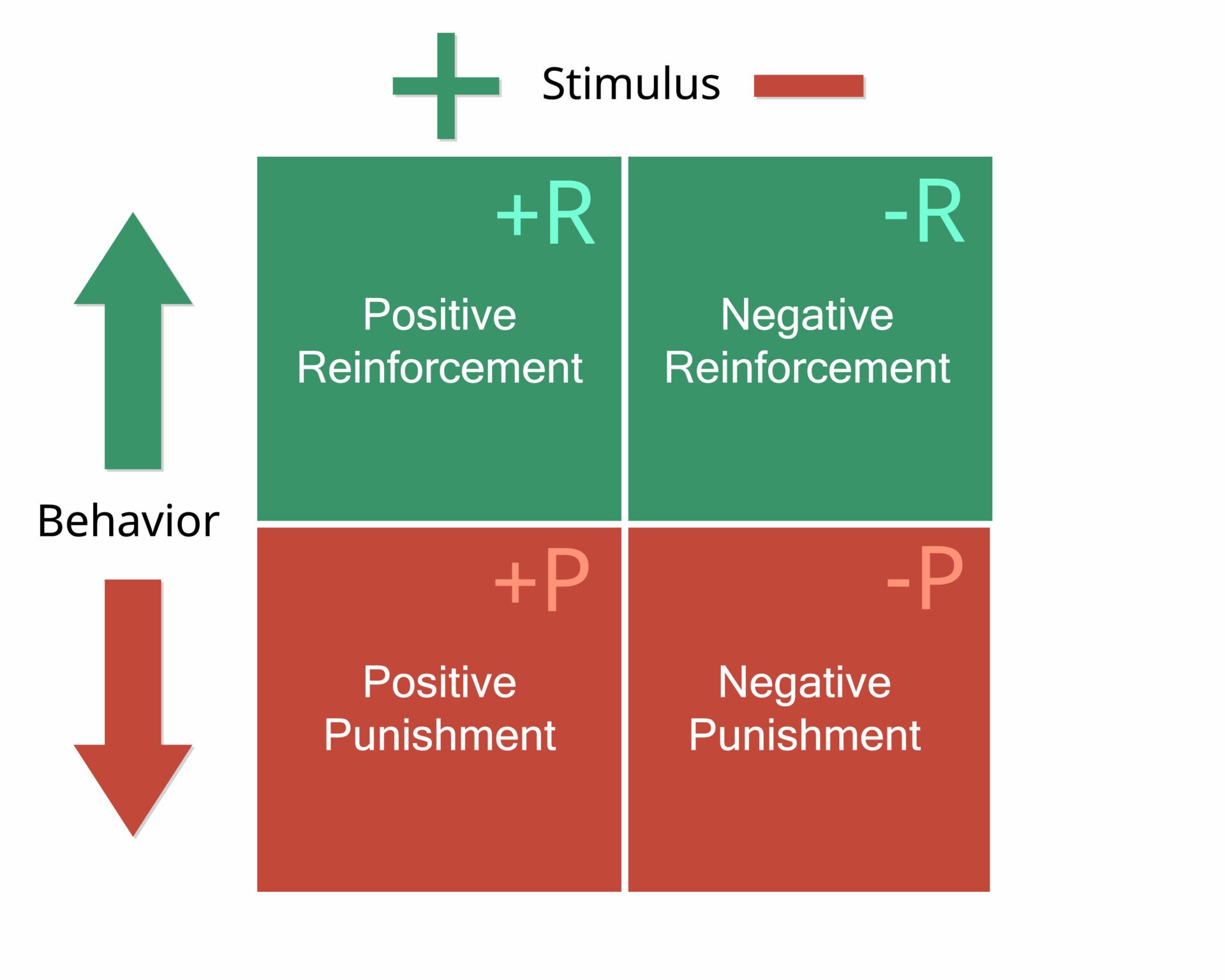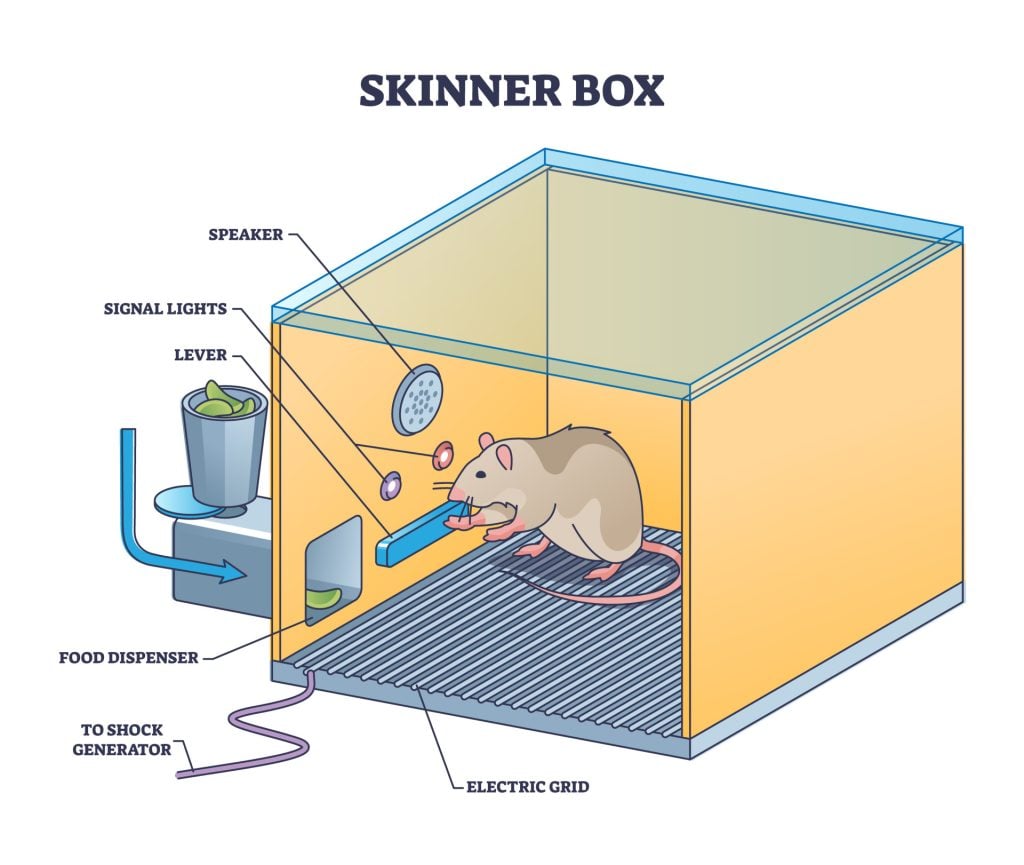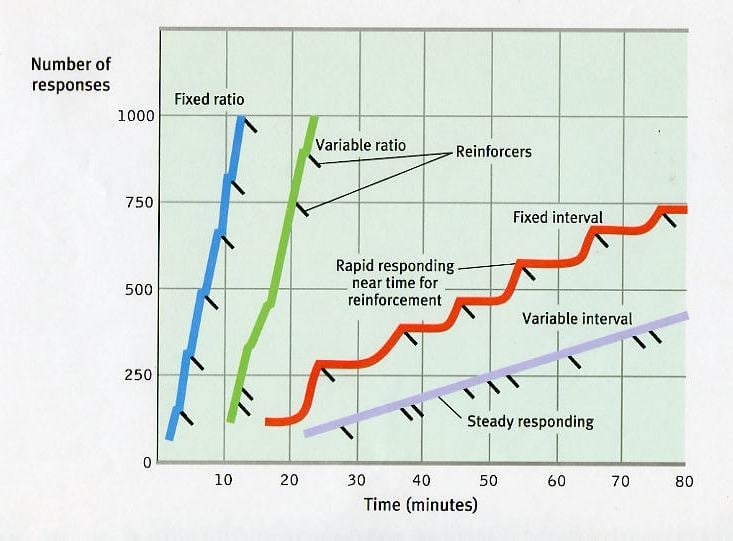On This Page:
Key Takeaways
- The concept of positive reinforcement is associated with the work of behaviorist psychologist B. F. Skinner. As part of his work during the 1930s and 1940s, Skinner considered ways in which behavior could be changed by treating someone differently based on what they did. This theory is known as operant conditioning.
- Positive reinforcement refers to the introduction of desirable or pleasant stimuli after the performance of a behavior. This reward can be used to further encourage that behavior, or change a pre-existing one.
- There are four types of positive reinforcers: natural, tangible, social, and token.
- Positive reinforcement can be delivered in experiments as part of a partially fixed schedule.
- Positive reinforcement has numerous consequences, both in the lab and the outside world, ranging from learning and workplace conduct to social media use.

How Does It Work?
Positive reinforcement is a basic principle of Skinner’s operant conditioning, which refers to the introduction of a desirable or pleasant stimulus after a behavior, such as a reward.
This desirable stimulus is intended to reinforce the behavior, making it more likely that the behavior will occur in the future. This could be used to teach new behaviors or strengthen existing ones.
Operant Conditioning is the theory that underlies Skinner’s positive reinforcement technique. In essence, the idea is that one can modify behavior by controlling the consequences that follow it.
Skinner argued that learning is an active process. When humans and animals act on and in their environment, consequences follow these behaviors. If the consequences are pleasant, they repeat the behavior, but if the consequences are unpleasant, they do not repeat the behavior.
Skinner believed that internal thoughts and motivations were not necessary to explain behavior. Instead, he believed that this explanation could come from external and observable causes (Staddon & Cerutti, 2003).
If a behavior is followed by a positive consequence (i.e., reinforcement), then that behavior is more likely to occur again in the future; conversely, if a behavior is followed by a negative consequence (i.e., punishment), then that behavior is less likely to occur again (Staddon & Cerutti, 2003).
Types of Positive Reinforcement
There are four types of positive reinforcers that can be used to encourage behaviors, each of which may be more or less effective depending on the individual and the situation (Kamery, 2004).
- Natural reinforcers are those that occur directly as a result of the behavior. For example, a person who creates a high-yielding campaign at work as a result of persistent research and effort may get raises and promotions at work.
- Social reinforcers involve expressing approval for desirable behavior. For example, a teacher or parent may praise a child, or an employer may call an employee’s work excellent (Kamery, 2004).
- Tangible reinforcers involve actual physical rewards for desirable behavior. These could include candy, treats, toys, money, or some other desirable object. While these rewards can be powerful, their overuse can disincentivize the behavior when they are not used (Kamery, 2004).
- Token reinforcers are points or tokens awarded for performing certain actions. These can then be exchanged for something of value. For example, a teacher may give a student points for completing assignments on time, which can be exchanged for a prize (Kamery, 2004).
Examples
Animal training
A classic use of positive reinforcement is in animal training and behavior. The general adage of animal training is to reward positive behaviors and ignore undesirable ones.
The use of positive reinforcement as a way of training animals dates to early psychological research, in particular, the works of B. F. Skinner.
Skinner devised a method of rewarding positive behavior called the Skinner box (Dezfouli & Balleine, 2012).
Essentially, this skinner box consists of a reinforcer — a lever or button that, when pressed in a certain way, delivers a reward such as food or water — and a tracker.

In this way, animals could learn to perform a task in a particular way to receive a reward. This is an example of tangible reinforcement (Dezfouli & Balleine, 2012).
In the workplace
Positive reinforcement can also be used in the workplace to encourage desirable behaviors. For example, an employer may give employees a bonus for meeting or exceeding sales targets.
This type of positive reinforcement is often called a “performance-related pay” or “pay for performance” system.
In another example, an employee who arrives at work on time every day may receive a gift card at the end of each month as a way of reinforcing timeliness.
Alternatively, an employer might give employees extra paid vacation days as a way of reinforcing good attendance (Ackerman, 2022).
It is important to note that positive reinforcement is not to be confused with bribery. Bribery happens when someone is given something in exchange for doing something that they otherwise would not do before it happens.
Meanwhile, positive reinforcement happens after the behavior has already been displayed. For example, an employee who already arrives to work on time every day cannot be bribed to do so — they are only eligible for positive reinforcement in the form of a reward (Ackerman, 2022).
Social Media
Social media use has skyrocketed in recent years, and positive reinforcement may be one of the reasons why. Platforms such as Facebook, Twitter, and Instagram all make use of likes, followers, and other forms of positive reinforcement to keep users engaged.
For example, a person who posts a photo on Instagram is likely to receive likes from their friends and followers. This, in turn, encourages that person to continue posting photos, as they have been positively reinforced for doing so.
Similarly, a person who tweets often and receives lots of replies and retweets is likely to continue tweeting, as they are being reinforced for their behavior.
It is important to note that not all social media platforms use positive reinforcement in the same way. Many traditional social media platforms, such as Instagram and Facebook, use a likes system to reward users for creating posts.
However, Snapchat does not use likes or followers as a form of positive reinforcement. Instead, the app uses streaks — that is, the number of consecutive days that two people have Snapchatted each other.
This encourages users to Snapchat each other frequently in order to maintain their streaks (Ackerman, 2022).
Schedules of Positive Reinforcement
An important aspect of Skinner’s research examines the
effectiveness of different patterns and frequencies of reward.
A positive reinforcement schedule is one that defines how someone looking to use positive reinforcement encourages behavior. There are five different positive reinforcement schedules (Ferster & Skinner, 1957).
- A continuous schedule, where the behavior is reinforced after each and every occurrence. This schedule, unfortunately, is difficult to maintain, as those enforcing behavior are rarely able to be present for every occurrence of it.
- A fixed ratio reinforcement schedule, where the behavior is reinforced after a specific number of occurrences. For example, a pigeon may receive a pellet after pecking three times.
- A fixed interval, where the behavior is reinforced after a specific amount of time.
- A variable ratio, where the behavior is reinforced after a variable number of occurrences. For example, a behavior may be reinforced after one occurrence, then after another three, then another two.
- A variable interval, where the behavior is reinforced after a variable amount of time. For example, after one minute, then 30 minutes, then 10 minutes.

These schedules depend on context. For example, an adult looking for a promotion at work may receive one annually, as long-term schedules tend to be effective for adults.
Meanwhile, a fixed ratio schedule may be effective for training a dog once it understands what behaviors are desirable.
Positive reinforcement is not the opposite of negative reinforcement
Both positive and negative reinforcement increases the likelihood of a behavior being repeated. The only difference is the type of consequence used to achieve this goal.
While positive reinforcement uses a desirable consequence to increase the likelihood of a behavior being repeated, negative reinforcement removes an unpleasant condition after the behavior is displayed, in order to increase its future occurrence (Dozier, Foley, Goddard, & Jess, 2019).
Negative reinforcement occurs when an unpleasant stimulus is removed after a behavior is displayed in order to increase the chance of that behavior being repeated.
For example, a smoker may feel relief after having a cigarette and so be more likely to smoke again in order to experience that relief (Cherry, 2018).
In contrast, positive reinforcement occurs when a pleasant stimulus is added after a behavior in order to increase its likelihood of being repeated.
Continuing with the above example, if a smoker was given a candy bar after smoking, they would be more likely to repeat the behavior in order to get the candy bar.
There is evidence that both positive and negative reinforcement can be effective in different ways. For example, recent research suggests that while positive reinforcement may be more effective in the short-term, negative reinforcement may actually lead to longer-lasting behavior change (Ferguson & Beaver, 2016).
It is important to note that not all reinforcers are created equal. Some people may respond well to one type of reinforcer but not to another.
It is also worth noting that some behaviors may be reinforced by both positive and negative reinforcement, depending on the individual (Ferguson & Beaver, 2016).
Ultimately, the decision of whether to use positive or negative reinforcement depends on the behavior being targeted, the individual displaying the behavior, and the desired outcome.
In the classroom
Positive reinforcement is a popular method of encouraging certain behaviors, both for the fact that it is an effective way to teach at the moment and one that is likely to be retained after the reinforcement ends.
One study on the use of positive reinforcement in the classroom shows that it can be used to significantly improve students’ behaviors and social skills, even after the reinforcer is removed (Diedrick, 2010).
For example, a teacher may give gold stars to students who turn in their work on time. This, in turn, encourages students to return to work in a consistent manner.
Others may be generous with praise or high-fives or hand out candy or small toys when students behave appropriately.
This positive reinforcement can be even more effective in the classroom when combined with peer pressure.
Often, children want to do the right things and may become embarrassed if caught doing something wrong in front of their friends and peers.
Thus, when there is a classroom of students watching, children become more receptive than usual to a reward (Ackerman, 2022).
Effectiveness
Numerous studies have shown that positive reinforcement does, indeed, work. The technique of positive reinforcement is also widely practiced in both research and everyday life.
For example, dog trainers often provide treats to their dogs as a way of encouraging the behaviors they want to see.
Similarly, parents and teachers have found that positive reinforcement can be extremely strong as a method of training children to behave appropriately (Ackerman, 2022).
Nonetheless, there are several different factors that control the likelihood that positive reinforcement would make it more likely that a behavior will be repeated.
The most important of these factors, it is widely agreed, is to provide the desirable stimulus as soon as possible after the desired behavior is performed.
The more time that passes between a behavior and a reward, the weaker the connection between the behavior and reinforcer is and the more likely that some intervening behavior occurs that may be reinforced instead.
On the positive side, positive reinforcement is seen as simpler than other methods of training, as it does not involve taking away rewards or introducing negative consequences for undesirable behavior.
This may improve the morale and motivation of the learner (Kamery, 2004). In general, scholars agree that it is easier to encourage behaviors than to discourage them, meaning that reinforcement is often a more powerful tool than punishment.
Finally, learning accompanied by positive feelings and associations is more likely to be remembered beyond the end of the reinforcement schedule (Ackerman, 2022).
Further Information
References
Ackerman, C. E. (2022). Positive Reinforcement in Psychology.
Bandura, A. (1977). Social learning theory. Englewood Cliffs, NJ: Prentice Hall.
Dezfouli, A., & Balleine, B. W. (2012). Habits, action sequences and reinforcement learning. European Journal of Neuroscience, 35 (7), 1036-1051.
Chen, C., Zhang, K. Z., Gong, X., & Lee, M. (2019). Dual mechanisms of reinforcement reward and habit in driving smartphone addiction: the role of smartphone features. Internet Research.
Dad, H., Ali, R., Janjua, M. Z. Q., Shahzad, S., & Khan, M. S. (2010). Comparison of the frequency and effectiveness of positive and negative reinforcement practices in schools. Contemporary Issues in Education Research, 3 (1), 127-136.
Diedrich, J. L. (2010). Motivating students using positive reinforcement (Doctoral dissertation).
Dozier, C. L., Foley, E. A., Goddard, K. S., & Jess, R. L. (2019). Reinforcement. The Encyclopedia of Child and Adolescent Development, 1-10.
Ferster, C. B., & Skinner, B. F. (1957). Schedules of reinforcement. New York: Appleton-Century-Crofts.
Gunter, P. L., & Coutinho, M. J. (1997). Negative reinforcement in classrooms: What we”re beginning to learn. Teacher Education and Special Education, 20 (3), 249-264.
Kamery, R. H. (2004, July). Motivation techniques for positive reinforcement: A review. I n Allied Academies International Conference. Academy of Legal, Ethical and Regulatory Issues. Proceedings (Vol. 8, No. 2, p. 91). Jordan Whitney Enterprises, Inc.
Kohler, W. (1924). The mentality of apes. London: Routledge & Kegan Paul.
Skinner, B. F. (1938). The behavior of organisms: An experimental analysis. New York: Appleton-Century.
Skinner, B. F. (1948). Superstition” in the pigeon. Journal of Experimental Psychology, 38, 168-172.
Skinner, B. F. (1951). How to teach animals. Freeman.
Skinner, B. F. (1953). Science and human behavior. SimonandSchuster.com.
Skinner, B. F. (1963). Operant behavior. American psychologist, 18 (8), 503.
Smith, S., Ferguson, C. J., & Beaver, K. M. (2018). Learning to blast a way into crime, or just good clean fun? Examining aggressive play with toy weapons and its relation with crime. Criminal behaviour and mental health, 28 (4), 313-323.
Staddon, J. E., & Cerutti, D. T. (2003). Operant conditioning. Annual Review of Psychology, 54 (1), 115-144.
Thorndike, E. L. (1898). Animal intelligence: An experimental study of the associative processes in animals. Psychological Monographs: General and Applied, 2(4), i-109.
Watson, J. B. (1913). Psychology as the behaviorist views it. Psychological Review, 20, 158–177.

